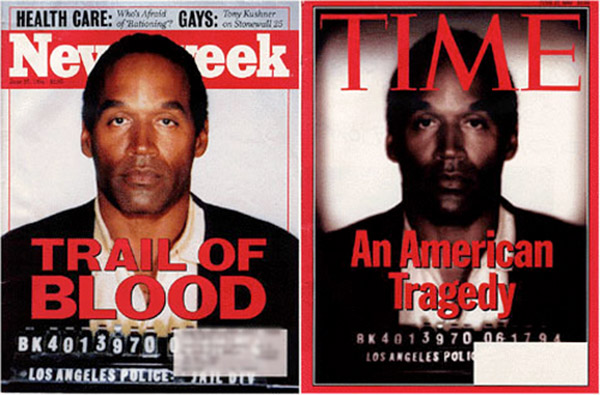

Newsweek uses words to trigger the audience into having thoughts that Simpson may be guilty. The phrase "Trial of Blood" is placed on top of Simpson's image, typed in bright, bold, red letters. This phrase has a strong connotation as it sounds extremely tragic and almost gives the feelings of a massacre. "Trial of Blood" sounds like the "Trail of Tears", which was the tragic, horrifying event that wiped out a tremendous amount of the Native American population. Newsweek uses these words to capture the audience's attention and evoke emotions of guiltiness and tragedy from them.
Time magazine takes a different approach from Newsweek in attempt to display Simpson as guilty. Aaron Gullickson, author of "The Significance of Color Declines: A Re-Analysis of Skin Tone Differentials in Post-Civil Rights America" states, "some anecdotal evidence suggests that whites have particularly negative stereotypes about darker-skinned blacks, such as the darkening of O.J. Simpson's face on Time magazine's cover" (Gullickson 159). This not only shows racism towards dark-skinned African-Americans but also how the same racism is portrayed through magazines. I later discuss the connotation of dark and light.
The image to the right, displays Time's front cover where Simpson's image has been drastically darkened. Time magazine decided to use this mug shot on its cover but first they asked photo-illustrator Matt Mahurin to artistically interpret it (Museum of Hoaxes). Mahurin darkened the photo. Time managing editor James Gaines offered this description of the resulting cover: "the harshness of the mug shot -- the merciless bright light, the stubble on Simpson's face, the cold specificity of the picture -- had been subtly smoothed and shaped into an icon of tragedy. The expression on his face was not merely blank now; it was bottomless" (Museum of Hoaxes). The contrast between the white background and Simpson's dark image makes him appear as if he were a horror story character. The photo-illustrator emphasized Simpson's dark skin complexion and made him appear even darker; through this, he was able to make it harder to see Simpson's face because it is being overpowered by darkness. According to the Museum of Hoaxes, "critics charged Time with racism, claiming that by darkening Simpson's features the magazine had emphasized his skin color and gave him a more 'menacing' appearance" (1). The darkening of Simpson's image demonizes him. According to Elena Stepanova, and Michael Strube, authors of "Making Of A Face: Role Of Facial Physiognomy, Skin Tone, And Color Presentation Mode In Evaluations Of Racial Typicality," the "cross-cultural color symbolism is present in race evaluation, with the color black connoting negative (e.g., blackmail, black Tuesday) and the color white connoting positive (e.g., Snow White, angels, white collar)" (69). In America, the color white is often associated with innocence, holiness, light and positivity. The color black is often associated with evil, negativity and darkness. In the past, "Black people were negatively defined as ugly, savage and barbaric; in contrast, White folks were positively defined as beautiful, Christian and civilized. These hierarchies of skin color, which systematically privileged lightness over darkness, perpetuated white supremacist beliefs about Blackness" (Gooden 82). Simpson already has dark skin but with Time's alterations, they have made him appear darker which makes him appear evil.
NEXT PAGE
Here is an image of famous NFL football star O.J. Simpson that was popularly featured on the front cover of magazines in 1994 during the People of the State of California vs. Orenthal James Simpson case, also known as the O.J. Simpson murder case. Simpson was at trial for the murder of his wife. Although Simpson was found innocent due to lack of evidence, magazines such as Newsweek and Time covered the case and featured Simpson's mug shot on their covers. Both magazines use the same picture of Simpson but take two different approaches to display the image, which in result evoke different emotions from viewing the covers. Newsweek's front cover reveals Simpson's image in its original state without dramatic alterations involving lighting. One can view Simpson's face easily. Simpson's serious facial expression makes him appear as innocent. Looking at his picture one may be able to perceive him as a nice, when considering his suit, clean haircut, and shaven face.